Betta Fish Types & Species For Your Aquarium
If you think bettas are just vibrant fighters in bowls, think again! The world of wild betta fish is a realm teeming with diversity and surprising behaviors. With a staggering 73 known species, these stunning fish are far more than their domesticated cousins.
Wild bettas offer captivating alternatives to the ubiquitous Siamese fighting fish. From tiny bubble-nesters to larger, fascinating mouthbrooders, each species boasts unique adaptations and personalities.
Types of Betta Fish
Here’s a
Betta Fish Are Not Easy To Care For! Click Here For What You Need to Know…
Here’s a glimpse into the diverse world of wild betta species:
- Betta Splendens (Siamese Fighting Fish): The iconic ancestor of domestic bettas, this species is known for its bold coloration and somewhat aggressive nature.
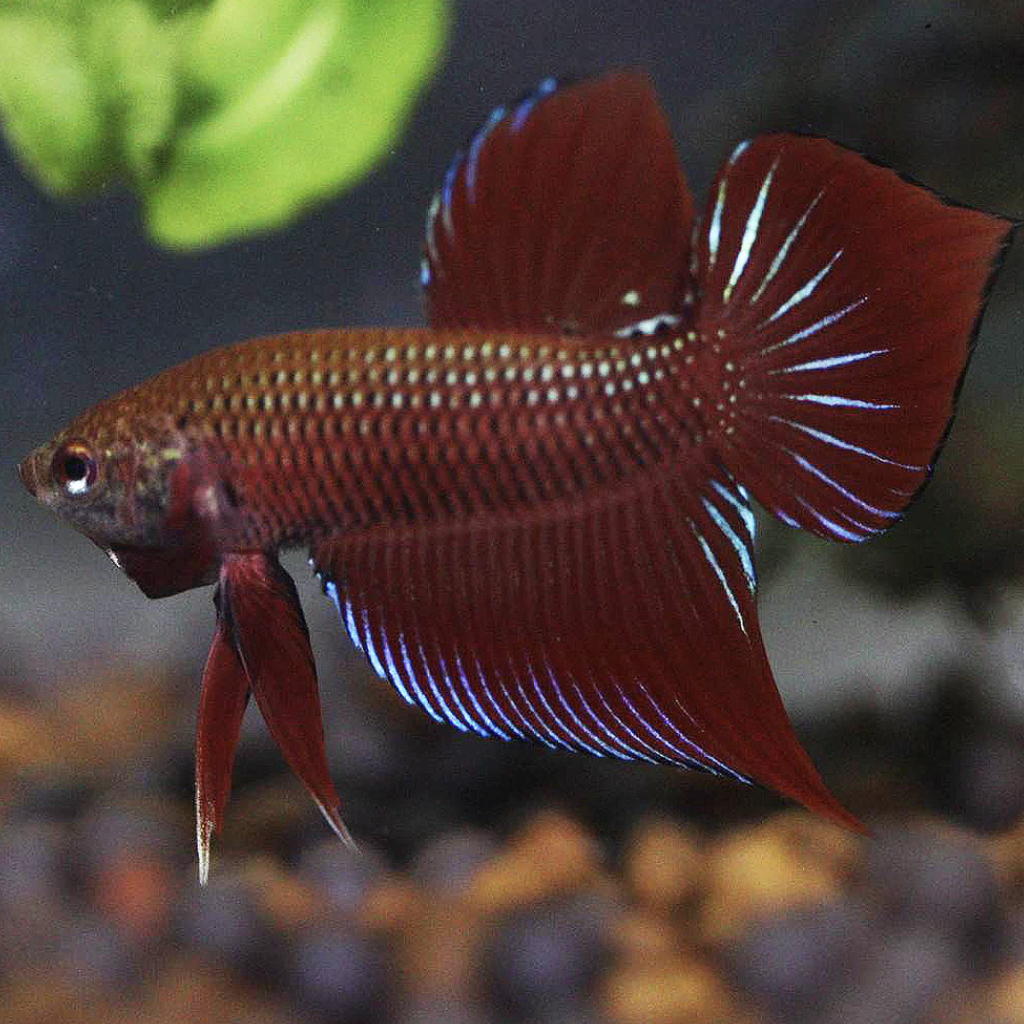
- Betta Imbellis (Peaceful Betta): This Malaysian beauty sports a shimmering green body with a striking red marking on its tail fin. They truly live up to their ‘peaceful’ name.
![]()
- Betta Smaragdina (Emerald Betta): This Thai stunner shimmers with iridescent green-blue scales and bursts of red in its fins. They’re one of the hardiest wild bettas, great for beginners!

- Betta Mahachaiensis (Mahachai Betta): Another Thai native, this betta sports metallic green scales, red fins, and a unique ‘mask’ of black across the face. They are close cousins of Betta splendens.

- Betta Macrostoma (Brunei Beauty): This large and powerful betta is a paternal mouthbrooder prized for its distinct markings. Males can change patterns in a flash, becoming remarkably colorful under certain conditions.
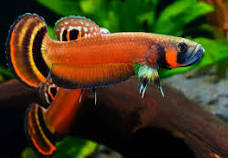
- Betta Coccina (Scarlet Betta): Bold red fins and a deep crimson body mark this fiery fish. They are mouthbrooders found in Indonesian peat swamps, where the water is soft and acidic.

- Betta Foerschi: A Bornean mouthbrooder that thrives in acidic waters and shares some coloration with Betta hendra.
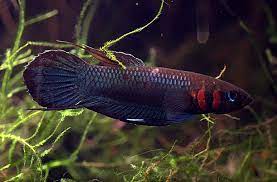
- Betta Rubra: This Sumatran wonder wows with its deep red hue. Males are fiercely devoted parents, protecting eggs and fry.
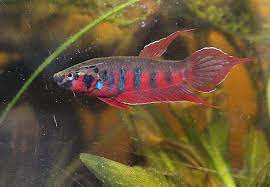
- Betta Channoides (Snakehead Betta): Instantly recognizable by its bright orange-red tones and surprisingly peaceful disposition. It’s perfect for those interested in a community of wild bettas.
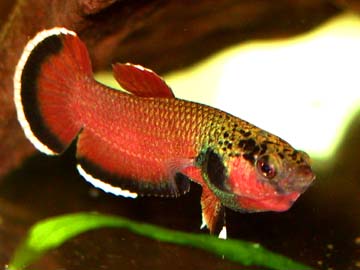
Stiktos Group
- Betta Stiktos: A tiny betta with a big personality. They sport a black body with a scattering of iridescent blue spots. Despite their size, males can be feisty and are known for their beautiful bubble nests.

Siamorientalis Group
- Betta Siamorientalis: This species features a striking blue body with a contrasting red splash on the gill cover. Known as the blue betta, it is also known for being relatively peaceful, they can sometimes be kept in community settings.

Commonly Found
-
Betta Pallifina: A mesmerizing betta with an almost translucent body and delicate fins sporting hints of blue and red. They prefer cooler waters than many other wild betta species.

-
Betta Hendra: This species shares some similarities with Betta foerschi, though it tends to have a more subdued coloration. They are mouthbrooders found in the same habitats as Betta foerschi.

-
Betta Uberis: Another mouthbrooding betta with a unique beauty. Their subdued body coloration is accented by vibrant blues and reds in their fins, resembling fireworks.

This list includes scientifically described species and some known by their locality or provisional names. The Betta genus is remarkably diverse, and new species are occasionally described as research progresses.
-
B. splendens complex (Fighting Fish)
• Betta splendens (Siamese fighting fish)
• Betta imbellis (Crescent betta)
• Betta smaragdina (Emerald betta)
• Betta mahachaiensis
• Betta siamorientalis
• Betta stiktosB. coccina complex (Wine Red Bettas)
• Betta coccina
• Betta livida
• Betta rutilans
• Betta tussyae
• Betta persephone
• Betta burdigala
• Betta brownorum
• Betta uberis
• Betta hendra
• Betta miniopinnaB. pugnax complex
• Betta pugnax (Penang betta)
• Betta fusca (Dusky betta)
• Betta prima
• Betta pallida
• Betta pulchra
• Betta schalleri
• Betta stigmosa
• Betta lehi
• Betta cracens
• Betta enisae
• Betta ferox
• Betta apollon
• Betta kuehnei
• Betta raja
• Betta breviobesaB. unimaculata complex
• Betta unimaculata
• Betta macrostoma (Spotfin betta)
• Betta patoti
• Betta ocellata
• Betta gladiator
• Betta ideii
• Betta compunctaB. albimarginata complex
• Betta albimarginata
• Betta channoidesB. akarensis complex
• Betta akarensis (Akar betta)
• Betta balunga
• Betta chini
• Betta ibanorum
• Betta obscura
• Betta pinguis
• Betta antoni
• Betta aurigans
• Betta nuluhonB. anabatoides complex
• Betta anabatoides (Giant betta)
• Betta midasB. bellica complex
• Betta bellica (Slim betta)
• Betta simorumOther notable species
• Betta foerschi
• Betta rubra
• Betta dimidiata
• Betta edithae
• Betta picta
• Betta taeniata
Types of Betta Fish Tails
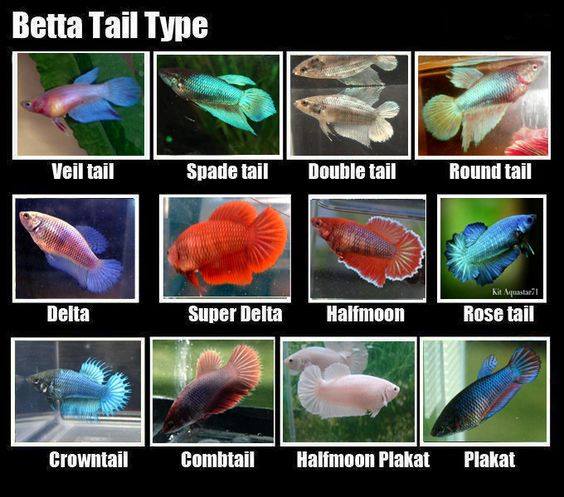
Betta Fish Tail Types
| Tail Type | Description | Care Difficulty | Special Needs |
|---|---|---|---|
| Veil Tail | Long, flowing, and asymmetrical tails | Easy | None |
| Crowntail | Spiky fins due to reduced webbing between the rays | Moderate | Frequent water changes to prevent fin damage |
| Halfmoon | Tails spread to 180 degrees, resembling a half-moon | Moderate | Prone to fin tears, needs gentle water flow |
| Double Tail | Two distinct caudal fins | Difficult | Susceptible to swim bladder disorder |
| Plakat | Shorter, more rounded fins, similar to wild Betta fish | Easy | None |
| Delta Tail | Triangular-shaped tails that widen at the tip | Moderate | Needs larger tank due to fin size |
| Super Delta | Enhanced Delta Tail that approaches a 180-degree spread | Moderate | Same as Delta Tail with additional care for fin health |
| Rosetail | Excessive branching of the fin rays | Difficult | Prone to tail-biting, needs monitoring |
| Feathertail | More extensive ruffles than Rosetail | Difficult | Prone to tail-biting, needs monitoring |
| Spade Tail | Tails shaped like a spade from a deck of cards | Moderate | None |
| Combtail | Mix between Crowntail and other types, with webbing extending more than Crowntails but less than traditional fins | Moderate | None |
| Round Tail | Rounded fins without the taper seen in Deltas | Easy | None |
| Elephant Ear (Dumbo) | Large pectoral fins resembling elephant ears | Moderate | Gentle water flow due to large pectoral fins |
| Over-Halfmoon | Tails extend beyond 180 degrees | Difficult | Similar to Halfmoon, with additional fin care |
| Half-Sun | Mix between Halfmoon and Crowntail, with rays extending beyond the caudal fin’s membrane | Difficult | Similar to Halfmoon, with additional fin care |
Embarking on Your Wild Betta Adventure: A Guide
Ready to bring the vibrancy of wild bettas into your aquarium? Click here for our article on betta fish care.
Consider these factors:
- Beginner’s Bettas: If you’re new to wild bettas, opt for species from the Betta splendens complex, like Betta imbellis, as they tend to be more forgiving.
- Mouthbrooder Marvels: For a taste of this unique behavior, the manageable size and potential for group living make Betta channoides a good starter.
- Advanced Beauty: Betta macrostoma (Brunei Beauty) rewards experienced aquarists seeking a challenge with its dazzling appearance.
Caring for a Piece of the Wild
- Know Your Betta: Research is essential! Understand your chosen species’ specific water needs, ideal tank setup, and dietary preferences.
- Nature’s Touch: To promote your betta’s health, replicate their natural environments, use plants and hiding places, and ensure proper water chemistry.
- Temperament Matters: Some wild bettas, particularly the wild-type Betta splendens, are territorial. Consider solitary setups or compatible tankmates carefully.
The Allure of Wild Bettas
Exploring the world of wild bettas is a journey rich in beauty and responsibility. From the gentle Betta imbellis to the dazzling Betta rubra, enthusiasts of all levels can discover a treasure. By responsibly caring for them, you gain a dazzling aquarium centerpiece while supporting the understanding and conservation of these fascinating fish.



